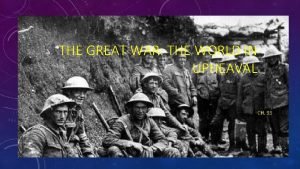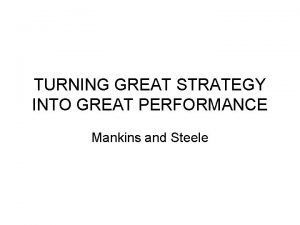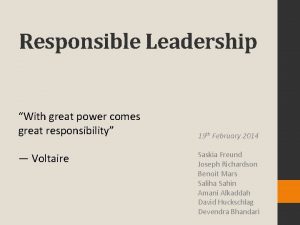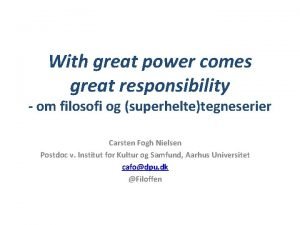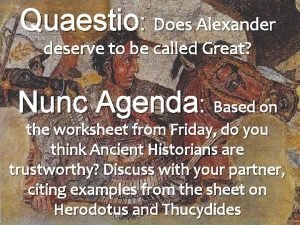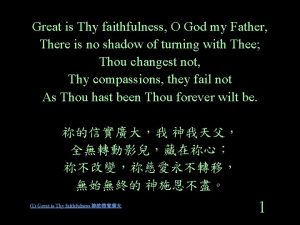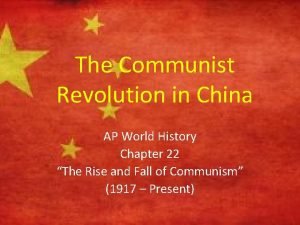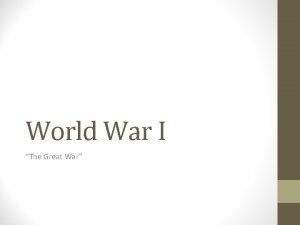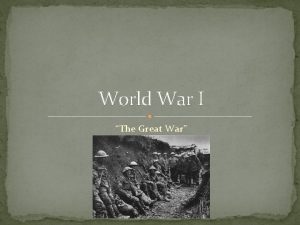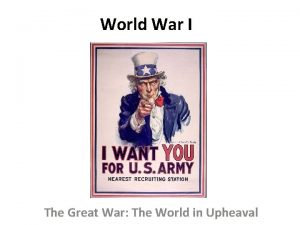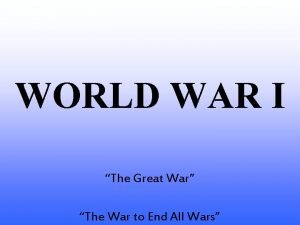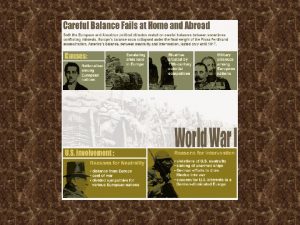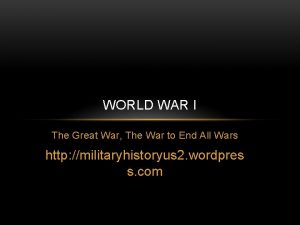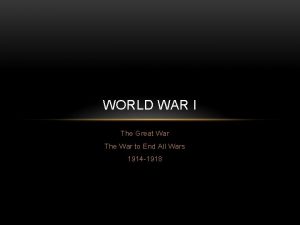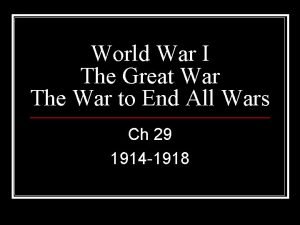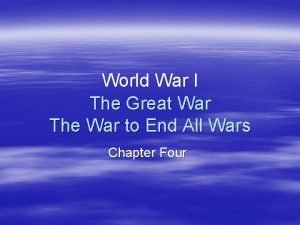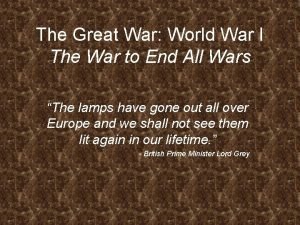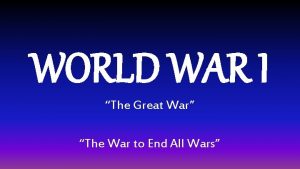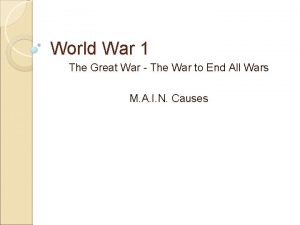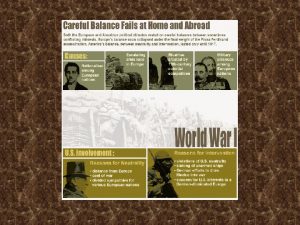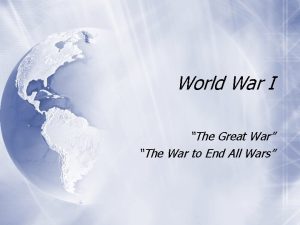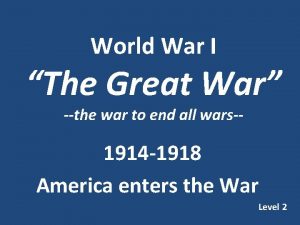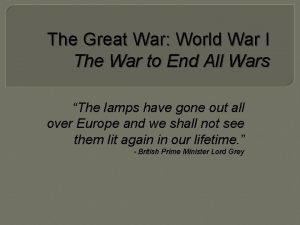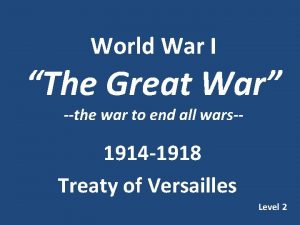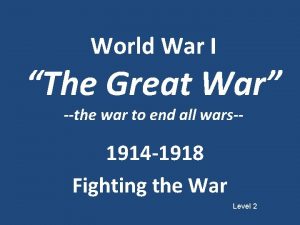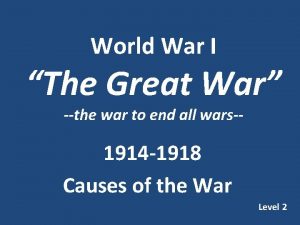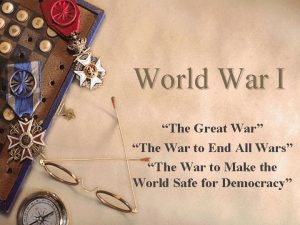World War I The Great War The War













































- Slides: 45

World War I The Great War The War to End All Wars The Trench War

Causes • OVER VIEW –Nationalism –Militarism and the Arms Race –Alliances –Imperialism

Nationalism • Nationalism- the feeling that your country is better than all others and that its interests should go before that of other countries or the world – Fierce competition evolved in everything from trade to the acquisition of colonies

Imperialism • The tendency towards imperialism led countries to shoot first and ask questions later…. . • There was a culture of expansionism that was common throughout the world Europe 1914

Imperialism • Became a “competition” between nations – Great Britain and Germany were racing to colonize Africa…. . Only Liberia and Ethiopia were independent – France and Germany were competing for control of Morocco – Russia was trying to control the Serbs and all of the Slovak people

Militarism • Arms race – when countries stockpile arms and expand armies as a show of strength – To justify expense there was often pressure to use force

Alliances • Alliances – mutual assurance of assistance in the event of attack • Allies – France, Great Britain and Russia • Russia and Serbia • Central Powers – Germany, Austria. Hungary, Ottoman Empire (Turkey) and Italy – Other small countries had side agreements that bound the larger powers as well

Trigger for War • June 28 th 1914 – Archduke Franz Ferdinand his wife were assassinated in Sarejavo – Group named “The Black Hand” Responsible • Their goal was to reunite all of Serbia • Causes chain reaction that leads to war

Alliances blow the event into World War • Austria-Hungary moves troops to put down any uprising in Serbia • Russia begins amassing troops and weapons on border with Austria Hungary in support of Serbia • Germany declares war on Russia in support of Austria. Hungary • France declares war on Germany and Austria-Hungary in support of Russia • Great Britain declares war on Germany in support of France • GAME ON!

War Begins

The War • 65 million men fought in the war • 20 million were wounded • 10 million dead • 20 million died of “other” causes – Starvation – Disease – Accidents

American Neutrality • Neutral – not to choose sides or “play Favorites – Public did not want to get involved in conflict 3000 miles away – 8 million German immigrants living in US – Close ties with Great Britain • Language • Trading partner – Signs of war atrocities started to sway public opinion

German U-Boats and European Blockade • Submarines – ship able to submerge under the sea, surface and fire torpedoes – Torpedo is a “swimming “ bomb that propelled itself though water to a target. – Germans sunk all ships, that might carry contraband – that stuff that helps an army to fight • Weapons, Food, Clothes etc.

Strategy • Germans attack through neutral Belgium – Easiest and shortest route to French Capital – Paris – French and English are able to stop advance and both sides dig in for the long haul. • Blockade of Europe with U-Boats • Increase Alliances – Mexico Europe – 1914

Weapons of War • Technology dramatically increased the effectiveness of the methods using in killing people. Trench Warfare Gas attach – Machine guns – some could shoot 500 rounds per minute – Artillery – big guns could shoot and exploding shell that weighed 1800 lbs. 9 miles (shell size that of a V. W. bug)

Air War • http: //www. youtube. com/ watch? v=x. A 4 SEp. U 3 Wv. M • Zeppelins • Fighter planes Albatross C III Fokker D VII – Dog Fights – Bombing runs Sopwith Camel

The Trench warfare made it very difficult forces to use traditional methods of fighting - frontal attacks were basically suicidal. - very difficult to do flanking maneuvers - all modes of transportation were too slow or too vulnerable to attack New weapons had to be developed to counteract the trench Medics help injured soldier in a trench.

Weapons of War • Chemical Weapons – Poison Gas • Nerve Gas – paralyzed the diaphragm, suffocating its victim. • Mustard Gas – burned skin and caused blindness – Flame throwers • Used gasoline or other accelerant sprayed in fine mist and ignited • Moveable Artillery – Tank • Use of armor to protect occupants of fighting vehicle – Idea of moveable weapons greatly changed they war was fought

Images of War US Engineer Battalion Destruction of bridge by artillery Americans in the trenches

US leans towards war • Lusitania – 1198 people were killed • 120 Americans – Germany threatens to sink all ships in international waters inbound to Europe

Zimmerman Note • Zimmerman Note – US intercepts coded message from German government to the German Ambassador to Mexico • Offers to assist Mexico to reclaim lands of Texas, New Mexico, California and Arizona if Mexico agrees to fight with the Germans • Offers “generous” monetary aid – Goal was to keep US occupied in the Western Hemisphere to prevent the US from entering the war in Europe.

Congress Declares War • American Public was slow to respond to the call of war – Congress institutes the Draft – 24 million men were registered for the draft • 3 million men were drafted through the lottery method • Women were not allowed to join up – Were allowed as noncombatants in some service areas – Lower pay and fewer benefits

Russian Revolution • Russian Revolution – Spring 1918 – Bolsheviks overthrew the Russian Czar and took over the country – Signed peace treaty with Germany and withdrew from the war – Allows Germany to focus troops on the Western Front

American Involvement • Russia signs separate peace agreement with the Germans – following their revolution • Germany was able to focus attacks on one front – the western front in France – American “doughboys” arrive just in time to slow and eventually stop the German advance in numerous battles. – Americans fought side by side with the French, British, and Italians in the trenches

Transporting Troops • Shipping became a priority industry during the war – All shipyard workers were exempt (excused) from the draft • Fabrication - method of ship-building that use parts made somewhere else that were assembled at the shipyard. – Dramatically cut down the time needed to build a ship

Convoy System • Strategy used to protect troop and supply ships from U-Boats as they crossed the Atlantic – Sailed in tightly packed formations – Surrounded by Naval Destroyers and Cruisers, who sailed in circles around the convoy • Used planes and subdestroyers to combat the U-Boats – Depth Charges World War 1 US Naval Destroyer

Doughboys • General Pershing put in Command of the American Expeditionary Force – Refused to split up forces to reinforce European units – Fought in coordination with European Troops but as a separate army • Allows Allies to reorganize troops and took a lot of pressure off of British and French troops

The War and the Economy • The Government took control of the Economy following the Declaration of War – President Created the War Industries Board to oversee production • Encouraged use of mass production techniques • Instituted Price Controls • Mediated Labor Disputes – Encouraged citizens to do without to promote the war effort through rationing • Meatless days, gasless Sundays, etc.

Financing the War • The immense cost of war was funded in 2 ways – Taxes • War Profits Tax on industries that profited from the war • Wealth Tax – taxed wealthy Americans at a higher rate • Luxury or Sin Taxes – taxed items like liquor, tobacco, and other vices – Liberty Bonds – individual citizens loaned money directly to the gov’t by purchasing bonds • On average every American loaned the government over $400 dollars – a very large amount at the time.

America at War • American forces joined the fight in May of 1918 – Were able to stop the German advance just 50 miles from Paris – Slowly Allied forces started to win victories and push the Germans back towards the border – Very costly in a series of battles • 48, 000 Americans dead from battle • 62, 000 Americans dead from disease • 200, 000 Americans wounded • Battle of the Argonne Forest had 140, 000 American casualties alone Americans in the trenches Germans in the trenches

Propaganda • The spreading of ideas, information or rumor for the purpose of helping or injuring a cause – Not necessary factual – Aimed at getting an emotional response – Tries to sway public opinion in a certain direction

Propaganda • President creates Committee on Public Information headed by George Creel – Movies, Books, pamphlets and music were created to support the War Effort – 4 minute men • 75, 000 men were hired to give 4 minute speeches on War programs – Victory gardens, rationing, liberty bonds and the draft – Millions of people heard these men speak throughout the country

The Espionage and Sedition Acts • Fear at Home – Following the Russian Revolution, people in the US feared the spread of communism – Congress passed the Espionage Act in 1917 that made it illegal to oppose the draft, war bonds or the arms industry. – Congress passed the Sedition Act in 1918 that made it illegal to use disloyal language in the press – Both were upheld by the Supreme Court because the country was at war – and major curbs on 1 st Amendment rights were OK when we are at war

Life at Home • Baseball – Pro baseball flourished • National Parks – National Park Service was created • 16 national parks were in existence at this time – Wide use of the Automobile allowed citizens to easily access parks – Hunting and Fishing became popular – Camping emerged as a way for people who could not afford cabins to enjoy the outdoors

Life at Home • Movies – Westerns were popular – shorts 10 -25 minutes in length – Charlie Chaplin became famous as “The Tramp” and earned a salary way over $1 million. – Full feature movies were introduced that lasted well over 3 hours

Science and Technology • Skyscrapers – Bridges and Tunnels • Panama Canal • Automobiles – Assembly line invented by Henry Ford • Cut assembly time from 14 hours per car to 93 minutes • Used prefabricated parts • Same methods were used in war production

The War Ends • November 11, 1918 at 11 AM in the morning, Germany surrenders to Allied Forces.

Peace • Kaiser abdicates thrown and new German govt. asks for cease fire • Flu pandemic strikes the US • Wilson delivers his 14 points speech • Peace Conference between the “Big Four” in Versailles, France – France, Great Britain, U. S. and Italy – Central Powers did not attend peace conference

Wilson’s 14 Points • President Wilson’s plan for lasting peace – First 5 dealt with causes of war • • • Outlawed secret diplomacy Outlawed secret treaties Outlawed the stockpiling of arms (Arms Race) Violations of the freedom of the seas Trade barriers – tariffs

14 Points • Nine of the points dealt with self-determination – How the people of Europe should govern themselves • Most important to Wilson was the creation of the League of Nations – Body designed to mediate disputes between nations and prevent offensive wars • There was considerable opposition to his plan from European political leaders

Versailles Peace Conference • Only attended by the Big Four – Central powers were not invited – Much compromise occurred on the 14 points in order to save the League of Nations – European Leaders wanted Germany to “pay” for the war • In $ • To be punished

Treaty of Versailles • Treaty was signed on June 28 th, 1919 – Redrew Map • Added Poland, Czechoslovakia, Yugoslavia – Demilitarized Germany – Forced Germany to pay reparations of $33 billion – Created League of Nations

Wilson’s last days • American Public wanted to remain Isolationist – not involved in World Affairs • Wilson refused to compromise on the Treaty of Versailles • Gave 35 speeches in 22 days and collapsed in exhaustion

Opposition to Treaty at Home • Congress did not like the idea of giving up power to a “world government” like the United Nations • Wilson tried to influence congress by doing a whistle stop tour and giving speeches all across America • He wore himself out and had a stroke that basically left him bedridden for the remainder of his presidency • The treaty never passed and we did not become members of the United Nations – European Leaders used this to punish Germany as much as possible – Much resentment was created in Germany – This lays the ground work for WW II. • US signed a separate peace treaty with Germany and the Central Powers

Aftermath of War • Communism and the Soviet Union • Beginning of Economic Expansion called the Roaring Twenties • Time of Great Societal Change – Constitutional Amendments – Changing Values • US as world power
 The great war: the world in upheaval
The great war: the world in upheaval Turning great strategy into great performance
Turning great strategy into great performance Great places great faces
Great places great faces Leadership comes with great responsibility
Leadership comes with great responsibility Great hammerhead shark vs great white shark
Great hammerhead shark vs great white shark Does alexander the great deserve his title
Does alexander the great deserve his title Frederick the great catherine the great enlightened despot
Frederick the great catherine the great enlightened despot With great expectations comes great responsibility
With great expectations comes great responsibility A great deal vs a great many
A great deal vs a great many With great power comes great responsibility batman
With great power comes great responsibility batman Does alexander deserve to be called the great
Does alexander deserve to be called the great Great is thy faithfulness oh god my father
Great is thy faithfulness oh god my father How did the great depression impact the world
How did the great depression impact the world Cultural revolution definition ap world history
Cultural revolution definition ap world history Mein kampf definition ap world history
Mein kampf definition ap world history Great expectations chapter 19
Great expectations chapter 19 Hình ảnh bộ gõ cơ thể búng tay
Hình ảnh bộ gõ cơ thể búng tay Frameset trong html5
Frameset trong html5 Bổ thể
Bổ thể Tỉ lệ cơ thể trẻ em
Tỉ lệ cơ thể trẻ em Chó sói
Chó sói Chụp phim tư thế worms-breton
Chụp phim tư thế worms-breton Hát lên người ơi
Hát lên người ơi Môn thể thao bắt đầu bằng từ chạy
Môn thể thao bắt đầu bằng từ chạy Thế nào là hệ số cao nhất
Thế nào là hệ số cao nhất Các châu lục và đại dương trên thế giới
Các châu lục và đại dương trên thế giới Công của trọng lực
Công của trọng lực Trời xanh đây là của chúng ta thể thơ
Trời xanh đây là của chúng ta thể thơ Cách giải mật thư tọa độ
Cách giải mật thư tọa độ Làm thế nào để 102-1=99
Làm thế nào để 102-1=99 độ dài liên kết
độ dài liên kết Các châu lục và đại dương trên thế giới
Các châu lục và đại dương trên thế giới Thơ thất ngôn tứ tuyệt đường luật
Thơ thất ngôn tứ tuyệt đường luật Quá trình desamine hóa có thể tạo ra
Quá trình desamine hóa có thể tạo ra Một số thể thơ truyền thống
Một số thể thơ truyền thống Cái miệng xinh xinh thế chỉ nói điều hay thôi
Cái miệng xinh xinh thế chỉ nói điều hay thôi Vẽ hình chiếu vuông góc của vật thể sau
Vẽ hình chiếu vuông góc của vật thể sau Nguyên nhân của sự mỏi cơ sinh 8
Nguyên nhân của sự mỏi cơ sinh 8 đặc điểm cơ thể của người tối cổ
đặc điểm cơ thể của người tối cổ V cc cc
V cc cc Vẽ hình chiếu đứng bằng cạnh của vật thể
Vẽ hình chiếu đứng bằng cạnh của vật thể Phối cảnh
Phối cảnh Thẻ vin
Thẻ vin đại từ thay thế
đại từ thay thế điện thế nghỉ
điện thế nghỉ Tư thế ngồi viết
Tư thế ngồi viết
